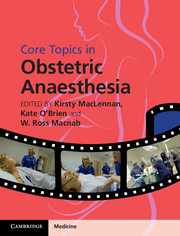Book contents
- Frontmatter
- Contents
- List of contributors
- Preface
- Section 1 Basic science, epidemiology and service organization
- Section 2 Obstetric aspects
- Section 3 Provision of anaesthesia
- 8 Incidental anaesthesia during pregnancy
- 9 Non-regional analgesia techniques for labour
- 10 Regional analgesia techniques for labour
- 11 Regional anaesthesia for operative delivery
- 12 General anaesthesia for caesarean section and transverse abdominal plane block
- 13 Anaesthesia for other obstetric indications: cervical suture, external cephalic version, controlled ARM, manual removal of placenta and perineal repair
- Section 4 Medical conditions in pregnancy
- Section 5 Postpartum complications and obstetric emergencies
- Section 6 Service organization
- Index
- Plate section
- References
11 - Regional anaesthesia for operative delivery
from Section 3 - Provision of anaesthesia
Published online by Cambridge University Press: 05 December 2015
- Frontmatter
- Contents
- List of contributors
- Preface
- Section 1 Basic science, epidemiology and service organization
- Section 2 Obstetric aspects
- Section 3 Provision of anaesthesia
- 8 Incidental anaesthesia during pregnancy
- 9 Non-regional analgesia techniques for labour
- 10 Regional analgesia techniques for labour
- 11 Regional anaesthesia for operative delivery
- 12 General anaesthesia for caesarean section and transverse abdominal plane block
- 13 Anaesthesia for other obstetric indications: cervical suture, external cephalic version, controlled ARM, manual removal of placenta and perineal repair
- Section 4 Medical conditions in pregnancy
- Section 5 Postpartum complications and obstetric emergencies
- Section 6 Service organization
- Index
- Plate section
- References
Summary
Introduction
The rate of general anaesthesia (GA) for caesarean section (CS) has fallen from 55% (1989–1990) to 9.4% (2011–2012). Over the same time period there has been an increase in CS rates from 11.3% to 25%. Despite the rise in CS rate there are approximately 70% fewer obstetric GAs performed per year nationally.
The reasons for this include:
• Increasing awareness of the risks of general anaesthesia in the parturient. The UKOSS study demonstrated a 1:224 risk of failed intubation
• The introduction of pencil point spinal needles, which have reduced the risk of post dural-puncture headache to an acceptable level (0.25%)
• Changes in maternal demographics: increasing numbers of women with morbid obesity and other co-morbidities
• Alteration in maternal expectations. Better information antenatally regarding the risks and benefits of regional anaesthesia vs. general anaesthesia allows women to make informed choices.
Benefits of regional anaesthesia (RA) for the woman include:
• The partner can be present throughout the delivery
• Maternal/neonatal skin-to-skin contact at the time of delivery can facilitate bonding
• The drugs used to provide RA do not affect uterine tone and there is minimal, if any, direct effect of these agents on fetal heart rate activity or fetal wellbeing
• The addition of neuraxial opioids provides excellent postoperative analgesia
• A reduction in the need for general anaesthesia reduces risks e.g. failed intubation.
Audit standards from the Association of Anaesthetists are that the proportion of CS under regional anaesthesia should be:
• Category 1 CS >50%
• Category 2–3 CS >85%
• Category 4 CS >95%.
Types of central anaesthetic neuraxial blockade
The CNB technique for delivery is dictated by:
• The experience of the anaesthetist
• The urgency of the decision-to-delivery interval (DDI):
• Category 1: immediate threat to the life of the mother or fetus (< 30 minutes)
• Category 2: no immediate threat to the life of woman or fetus (< 75 minutes)
• Category 3: requires early delivery (> 75 minutes)
• Category 4: at a time to suit the woman and the maternity service
• Co-morbidities, e.g.:
• Obesity
• Pre-eclampsia
• Cardiac disease
• Respiratory disease
• Whether the in-situ epidural is satisfactory enough to top-up.
- Type
- Chapter
- Information
- Core Topics in Obstetric Anaesthesia , pp. 73 - 82Publisher: Cambridge University PressPrint publication year: 2015



